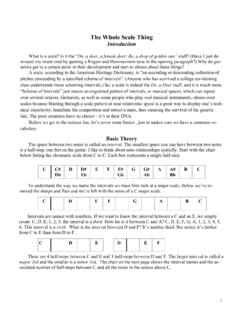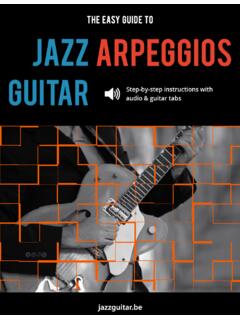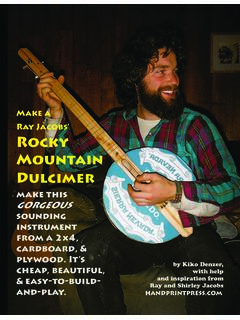Transcription of Table of Contents Introduction: Theory, Triads and ...
1 1 2008 - 2010, Randy Wimer Table of Contents introduction : Theory, Triads and Terminology .. 3 Understand the building blocks of chords. Learn the often inconsistent jargon associ-ated with playing jazz chords. Section 1: Functional Literacy .. 17 Start with the open position chords you learned when you first started; add some ba-sic bar chords, a couple of major sevenths and a few diminished chords. Soon you can play most of the songs you ve ever heard. Section 2: The CAGED System .. 26 The time honored approach to adding chords to your vocabulary: Learn how the C, A, G, E, and D chords combine to cover one octave on the guitar neck; build exten-sions on those chords and suddenly instead of two ways to play a given chord , you have 5.
2 Section 3: Building Chords on String Sets .. 47 Look at the 6 stings of the guitar in groups of 4. Build basic chords on these 4-string groups and you go from 5 ways to play most chords to 16! Interlude: Terminology; Drop 2 and Drop 3 Voicing .. 57 More droppings? An explanation of some common terms. Section 4: Seeing all the Possibilities .. 58 Stop thinking like a guitar player and start thinking like a musician. Play some fairly sick versions of House of the Rising Sun to make my point. Section 5: Reprise: More Fun With Triads .. 68 What can I say? I have this thing for symmetry. End where we began but with a whole new set of tools to use. Appendix: Photo-op A must have for any guitarist who doesn t want to be memorialized on film (or pixels) playing a simple E minor chord .
3 2 2008 - 2010, Randy Wimer Foreword First, this book is for everyone who has made it through the beginning phases of learning guitar. If you re ready to expand your chord vocabulary, this book is for you. Second, this book is not meant to be worked through in a month or three. The material in each sec-tion should be learned and then incorporated into the guitarist s everyday playing before proceeding to the next section. If you re just starting out, work through the Functional Literacy section and live with it for a while. Apply those new chords to songs you know. Learn some new songs you couldn t play before. When that material is easy for you, when you ve internalized the ideas, then move on to the CAGED chapter. What I ve tried to do in this slender volume is to chronicle the normal evolutionary cycle of guitarists who develop a truly deep understanding of harmony applied to the guitar fretboard.
4 It s the path I went down over the course of many years. It s the same or very similar to the paths that many of my friends and colleagues have followed. And yet I ve never seen the material presented in this fashion. Hopefully this will provide some markers on the trail for aspiring guitarists. 3 2008 - 2010, Randy Wimer 4 2008 - 2010, Randy Wimer The Whole chord Thing introduction Shredders get all the attention. But even they know in their heart of hearts that real mastery of the in-strument is shown through a clear understanding of chords and how they work on the guitar fretboard. Working through this book will allow you to accomplish two things: 1) you will acquire a firm grasp of chord theory along with the basic chord shapes to get you through most playing situations - whether you re playing in a 3-piece rock band or a 17-piece jazz ensemble; 2) you will acquire the tools to define your own chord voice.
5 Joe Pass played chords differently from Barney Kessel. Alan Holdsworth plays chords dif-ferently than Frank Gambale. If you really want to master the guitar, your chordal style needs to be as per-sonal as your improvisation style. In the introductory section of this book we ll look at the rules of music theory that govern chord build-ing; we ll take a detailed look at Triads ; and we ll try to unravel the sometimes arcane and conflicting termi-nology that applies to chords. Basic Theory The space between two notes is called an interval. The smallest space you can have between two notes is a half-step, one fret on the guitar. I like to think about note relationships, and eventually chords, spatially. Start with the chart below listing the notes of a one-octave chromatic scale from C to C.
6 Each box repre-sents a single half-step. C C# Db D D# Eb E F F# Gb G G# Ab A A# Bb B C To understand the way we name the intervals we must first look at a major scale. Below we ve re-moved the sharps and flats and we re left with the notes of a C major scale. C D E F G A B C Intervals are named with numbers. If we want to know the interval between a C and an E, we simply count: C, D, E; 1, 2, 3; the interval is a third. How far is it between C and A? C, D, E, F, G, A; 1, 2, 3, 4, 5, 6; This interval is a sixth. What is the interval between D and F? It s another third. But notice it s farther from C to E than from D to F. D E F C D E There are 4 half-steps between C and E and 3 half-steps between D and F. The larger interval is called a major 3rd and the smaller is a minor 3rd.
7 The chart below shows the interval name and the associated num-ber of half-steps between C and all the notes in the octave above C. C Db D Eb E F Gb G Ab A Bb B C 0 1 2 3 4 5 6 7 8 9 10 11 12 unison Minor 2nd Major 2nd Minor 3rd Major 3rd Perfect 4th dimin-ished 5th Perfect 5th Minor 6th Major 6th Minor 7th Major 7th Perfect octave 5 2008 - 2010, Randy Wimer The first note is an F sharp (note the key signature) and the second is an A flat. That s a distance of 2 half-steps, or one whole step. But, again, we have to consider the letter names of the notes, F and A. That s F, G, A; 1, 2, 3, so the interval has to be a kind of third. A major third is 4 half-steps, a minor third is 3 half-steps. This new beast is called a diminished third.
8 I tend to relate this stuff back to the intervals derived from the major scale. In the C major scale, C to A is a major sixth; C to A flat is a minor sixth. We can make that interval smaller (diminished, get it?) by either raising the the C to a C sharp or low-ering the A flat to an A double-flat. Either case would be called a diminished sixth. Will you need to under-stand diminished intervals to complete your knowledge of chords? Not really - where it becomes relevant is in formal music theory study, generally within the first couple of college music theory. It that s not your path then consider it knowledge for knowledge s sake. Not a bad thing. TMI Warning If you get a good handle on the information so far, that s really most of what you need to understand how chords are built.
9 Next bit may come under the heading of too much information. If you be-gin to bog down in the rest of the material on intervals, don t worry. Skip it for now and come back to it after you ve had a chance to digest for a while. Notice that the sharps have been removed from the preceding chart. There are other considerations be-sides the number of half-steps when identifying intervals: C to D# is not the same as C to Eb. Yes, D# and Eb are the same pitch, but when identifying intervals you also have to consider the letter names of the notes. Count the letters from C to D# - it s still C, D; 1, 2 - a second of some kind even though it s a D#. We call that space an augmented second. The chart below uses the sharps and the alternate names of the intervals.
10 C C# D D# E F F# G G# A A# B C 0 1 2 3 4 5 6 7 8 9 10 11 12 unison Aug-mented unison Major 2nd Aug 2nd Major 3rd Perfect 4th Aug 4th Perfect 5th Aug5th Major 6th Aug 6th Major 7th Perfect octave So, you ve got this interval thing covered, right. Not quite. There is one (only one, I promise) more thing to consider when naming intervals: mixed accidentals - the use of sharps in a flat key signature (or vice-versa). Consider the following: 6 2008 - 2010, Randy Wimer Using Intervals to Build Chords: Triads Minor Third Major Third Major Third Major Third Major Third Minor Third Minor Third Minor Third Start with two basic rules: Chords are built in thirds; and chords must contain at least 3 dif-ferent tones. There are two types of thirds (that we deal with here), major 3rds (4 half-steps) and minor 3rds (3 half-steps).



